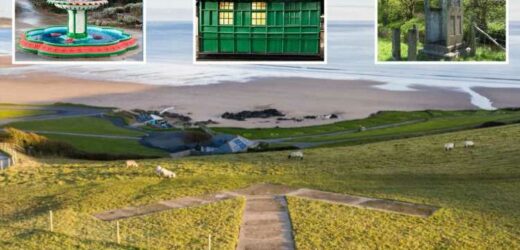A TELEPHONE kiosk and a giant concrete arrow are among the unusual new sites given protected status.
Heritage England has added more than 500 buildings to its protected list meaning that the sites cannot be demolished or altered without special permission from local authorities.
A K1 phone kiosk – the country's first phonebox in West Yorkshire – has been granted grade II status along with a WWII practise bombing range in Devon.
Porchester Hall in London – used in Monty Python's 1982 film The Meaning of Life – is also featured.
Two 19th century sail-assisted steamer shipwrecks off the coast of Norfolk, The Seagull and the Xanthe.
Both remain upright and in reasonably good condition on the seabed.
There's also a clipper ship wreckage, The South Australian, in the Bristol Channel, that carried cargo and even a bridge between London and South Australia.
Built in 1577, Tudor Curtain Playhouse in Shoreditch, London, site was lost but then discovered again during excavations in 2011.
The freshly unearthed theatre staged Romeo and Juliet in Shakespeare's lifetime and even has the bard himself on their performer list.
Moving away from literary history and into something a bit more industrial, a vertical spinning tunnel in Twinwoods Business Park, Bedfordshire, that was used to test aerodynamics post-WWII is now Grade II.
The unique structure worked by blowing air upwards against the gravitational force on a free-falling aircraft model, allowing the study of the ways in which an aircraft could enter a spin and how to recover from it.
Its construction pioneered the technique of welding on site pre-formed metal plates for the assembly of large pressure vessels.
Liverpool gets a look in with the Bucket Fountain, formally known as Piazza Fountain, which was made in the 1960s by Liverpool University alumni Richard Huws and is the only survivor of his water sculptures.
It includes 20 hoppers that tip unexpectedly and signify Liverpool's importance as an international port.
It is also the first and best preserved Victorian Turkish bath in England, opening in 1857.
From over 500 Turkish baths which once existed in England, there are only five that are still in use today, of which Porchester is deemed to be the best example.
Moving from London to the Midlands, the new list includes Birmingham's stunning red brick Children's Hospital and an old phone box.
A K1 telephone kiosk that's sat in a field in West Yorkshire has been Grade II listed. It is believed to have been designed and put up in 1922.
It is one of seven examples of Britain's first national telephone network boxes and is a precursor to the famous red ones that everyone knows and loves.
In Suffolk a chemist's that was built in 1851 for Robert Morris for the business he started in 1817, has been made Grade II.
The building, sat on Lowestoft High Street, was still in use in 2012 and its shopfront has remained largely unaltered for centuries.
Heritage Minister Helen Whately said: “England is home to many historic, iconic, and sometimes quirky sites.
"Protecting our heritage is of huge importance so future generations can better understand all the things that have made this nation great.
"I'm delighted that such a diverse range of important and interesting places were protected by Historic England in 2019.”
Source: Read Full Article





















